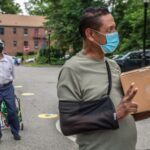Disaster preparedness efforts and the need for disaster-prepared communities in San José have substantially increased the need for more involvement at the community level. This project is a collaboration with Japantown Prepared and Hensley Historic District to understand how to build a stronger, more cohesive community through disaster preparedness. I explored how risk perception and vulnerability to disasters varied among research participants, how their views of disaster influenced their own preparedness and mitigation strategies, and explored questions concerning resources or assets within the community that people would need in the event of a disaster. By addressing these core questions, Project Prepared aimed to achieve create a localespecific and community-centered approach to disaster planning in Japantown and Hensley Historic District. Project Prepared also intended to encourage residents to feel a stronger sense of connection and commitment to their community (particularly among populations in the community that are at most risk during a disaster, such as those experiencing homelessness, senior citizens, families with young children and immigrants with limited English proficiency). Efforts to increase community members’ connection included personally inviting community members to attend meetings and disaster preparedness events. Project Prepared aimed to increase overall engagement and participation from the broader community, rather than relying solely on the small group currently dedicated to disaster preparedness and helped implement solutions to increase engagement. I developed a project to address the preparedness gap between different stakeholders and residents in Japantown and Hensley Historic District and inform my project community partners on best practices, drawn from interviews and participant observation.
The management of volunteers – What can human resources do? A review and research agenda
There is an increasing interest from scholars and practitioners in understanding how non-profit organizations can design and implement human resources (HR) practices to enhance desirable volunteer attitudes and behaviors. This paper presents a comprehensive overview of existing studies on the relationship between HR practices and volunteering outcomes. We use the ability-motivation-opportunity model as a guiding…

